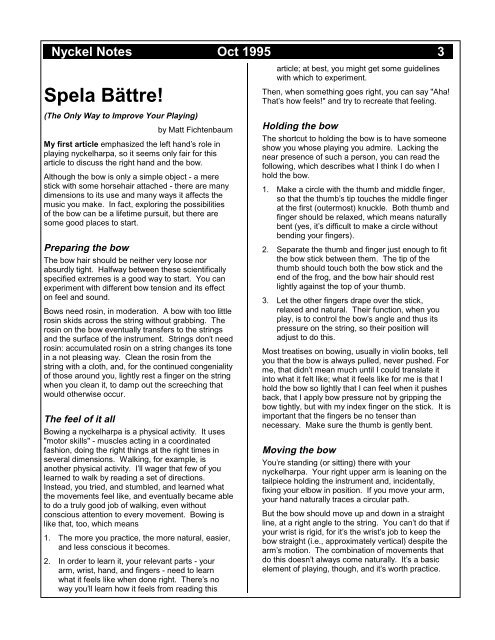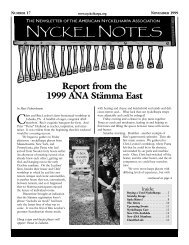Download Number 2 - American Nyckelharpa Association
Download Number 2 - American Nyckelharpa Association
Download Number 2 - American Nyckelharpa Association
You also want an ePaper? Increase the reach of your titles
YUMPU automatically turns print PDFs into web optimized ePapers that Google loves.
Nyckel Notes Oct 1995 3<br />
Spela Bättre!<br />
(The Only Way to Improve Your Playing)<br />
by Matt Fichtenbaum<br />
My first article emphasized the left hand’s role in<br />
playing nyckelharpa, so it seems only fair for this<br />
article to discuss the right hand and the bow.<br />
Although the bow is only a simple object - a mere<br />
stick with some horsehair attached - there are many<br />
dimensions to its use and many ways it affects the<br />
music you make. In fact, exploring the possibilities<br />
of the bow can be a lifetime pursuit, but there are<br />
some good places to start.<br />
Preparing the bow<br />
The bow hair should be neither very loose nor<br />
absurdly tight. Halfway between these scientifically<br />
specified extremes is a good way to start. You can<br />
experiment with different bow tension and its effect<br />
on feel and sound.<br />
Bows need rosin, in moderation. A bow with too little<br />
rosin skids across the string without grabbing. The<br />
rosin on the bow eventually transfers to the strings<br />
and the surface of the instrument. Strings don’t need<br />
rosin: accumulated rosin on a string changes its tone<br />
in a not pleasing way. Clean the rosin from the<br />
string with a cloth, and, for the continued congeniality<br />
of those around you, lightly rest a finger on the string<br />
when you clean it, to damp out the screeching that<br />
would otherwise occur.<br />
The feel of it all<br />
Bowing a nyckelharpa is a physical activity. It uses<br />
"motor skills" - muscles acting in a coordinated<br />
fashion, doing the right things at the right times in<br />
several dimensions. Walking, for example, is<br />
another physical activity. I’ll wager that few of you<br />
learned to walk by reading a set of directions.<br />
Instead, you tried, and stumbled, and learned what<br />
the movements feel like, and eventually became able<br />
to do a truly good job of walking, even without<br />
conscious attention to every movement. Bowing is<br />
like that, too, which means<br />
1. The more you practice, the more natural, easier,<br />
and less conscious it becomes.<br />
2. In order to learn it, your relevant parts - your<br />
arm, wrist, hand, and fingers - need to learn<br />
what it feels like when done right. There’s no<br />
way you’ll learn how it feels from reading this<br />
article; at best, you might get some guidelines<br />
with which to experiment.<br />
Then, when something goes right, you can say "Aha!<br />
That’s how feels!" and try to recreate that feeling.<br />
Holding the bow<br />
The shortcut to holding the bow is to have someone<br />
show you whose playing you admire. Lacking the<br />
near presence of such a person, you can read the<br />
following, which describes what I think I do when I<br />
hold the bow.<br />
1. Make a circle with the thumb and middle finger,<br />
so that the thumb’s tip touches the middle finger<br />
at the first (outermost) knuckle. Both thumb and<br />
finger should be relaxed, which means naturally<br />
bent (yes, it’s difficult to make a circle without<br />
bending your fingers).<br />
2. Separate the thumb and finger just enough to fit<br />
the bow stick between them. The tip of the<br />
thumb should touch both the bow stick and the<br />
end of the frog, and the bow hair should rest<br />
lightly against the top of your thumb.<br />
3. Let the other fingers drape over the stick,<br />
relaxed and natural. Their function, when you<br />
play, is to control the bow’s angle and thus its<br />
pressure on the string, so their position will<br />
adjust to do this.<br />
Most treatises on bowing, usually in violin books, tell<br />
you that the bow is always pulled, never pushed. For<br />
me, that didn’t mean much until I could translate it<br />
into what it felt like; what it feels like for me is that I<br />
hold the bow so lightly that I can feel when it pushes<br />
back, that I apply bow pressure not by gripping the<br />
bow tightly, but with my index finger on the stick. It is<br />
important that the fingers be no tenser than<br />
necessary. Make sure the thumb is gently bent.<br />
Moving the bow<br />
You’re standing (or sitting) there with your<br />
nyckelharpa. Your right upper arm is leaning on the<br />
tailpiece holding the instrument and, incidentally,<br />
fixing your elbow in position. If you move your arm,<br />
your hand naturally traces a circular path.<br />
But the bow should move up and down in a straight<br />
line, at a right angle to the string. You can’t do that if<br />
your wrist is rigid, for it’s the wrist’s job to keep the<br />
bow straight (i.e., approximately vertical) despite the<br />
arm’s motion. The combination of movements that<br />
do this doesn’t always come naturally. It’s a basic<br />
element of playing, though, and it’s worth practice.
















